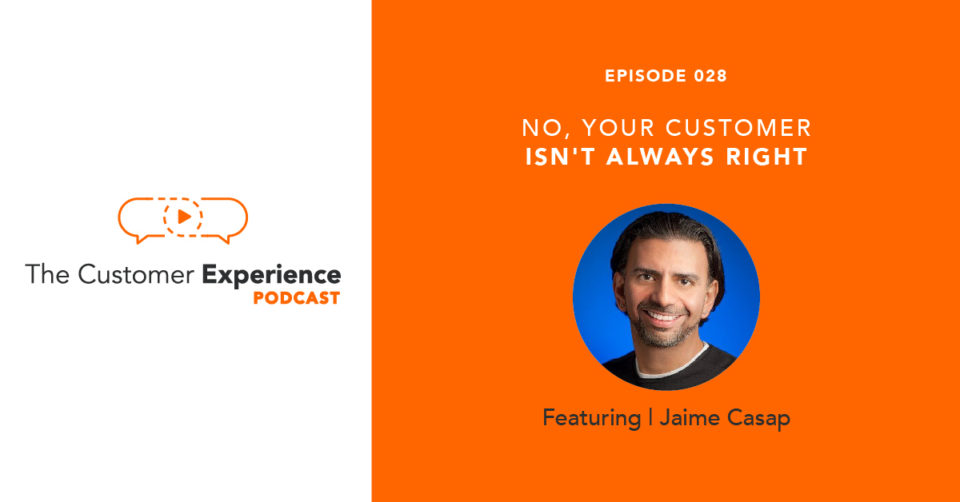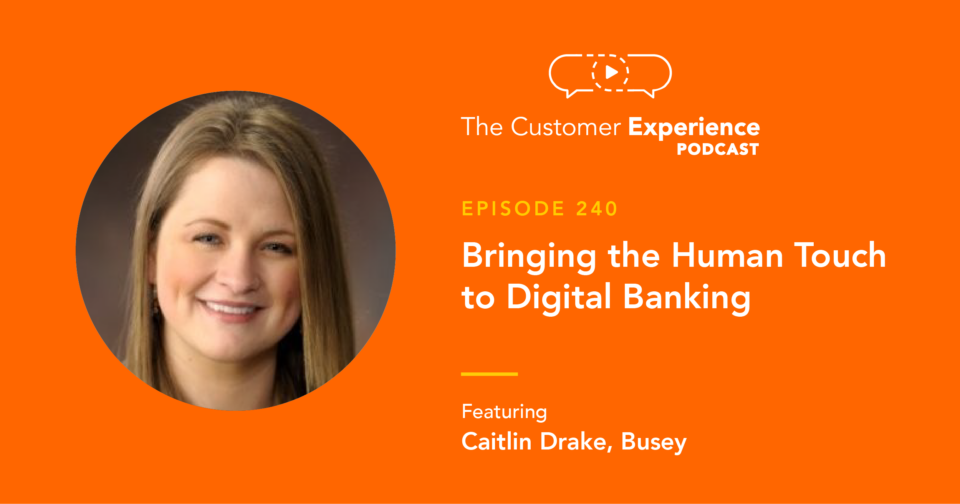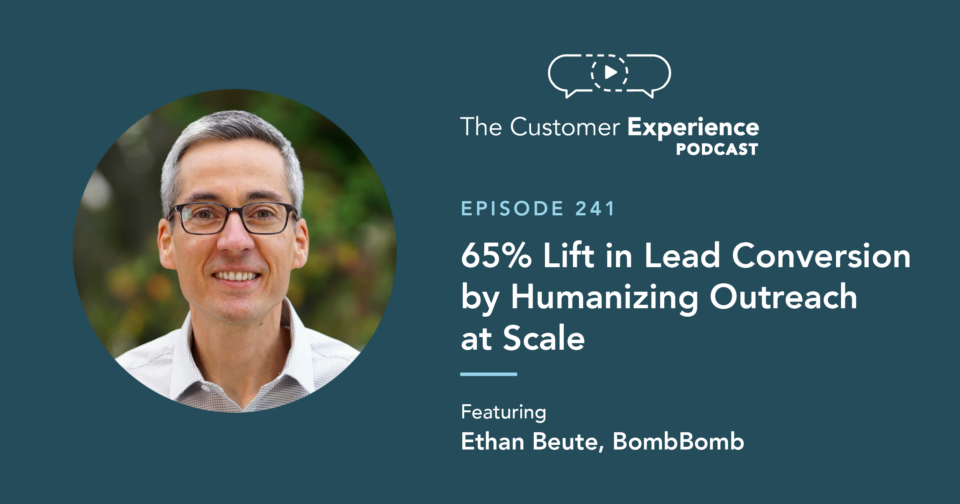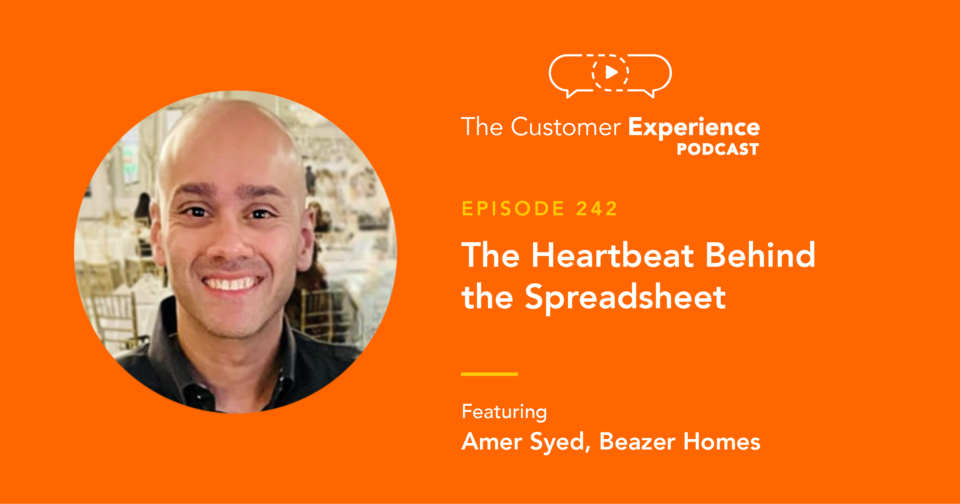
Listen to “28. No, Your Customer Isn't Always Right w/ Jaime Casap” on Spreaker.
Apple Podcasts | Google Podcasts | Stitcher | Spotify
Behind the phrase “the customer is always right” is an interesting origin story. It dates back more than 100 years to retailers like Marshall Fields and Selfridges. And it may not have been intended to be taken literally, even though many people have.
In this episode of The Customer Experience Podcast, Jaime Casap, Chief Education Evangelist at Google, buries the concept while providing a better approach to serving our stakeholders and improving customer experience.
Playing an integral role in the launch of the G-Suite, Chromebooks, and other Google tools in education over the past 12+ years, Jaime believes that education disrupts poverty and that technology changes lives.
He speaks internationally on the future of education, the future of work, technology and innovation, and Generation Z. And he brings many of his thoughts, ideas, and opinions to this fast, fun, and valuable conversation, including:
- Why “What do you want to be when you grow up?” is the wrong question
- What a better question to ask is, plus two follow-up questions
- Why the customer isn’t always right (and what to do about it)
- How to serve students, parents, administrators, professional speakers, consumers, and others as customers
- How to be a more persuasive speaker and a more persuasive person
- How he views competitors like Apple and Microsoft in the education space
- Why Howard Stern is an exceptional interviewer
- How and why he’s building his YouTube channel
- Much more!
Below are the highlights of our conversation, which I expect you’ll enjoy!
No, Your Customer Isn’t Always Right
To listen to this episode on the go, as well as any or every other conversation, please subscribe to The Customer Experience Podcast:
You can also listen to the episode with Jaime Casap right here…
Listen to “28. No, Your Customer Isn't Always Right w/ Jaime Casap” on Spreaker.
Google’s Competition (or Not) with Microsoft and Apple
“I have no idea what Microsoft and Apple are doing. I don’t care,” Jamie confesses before adding “All I care about are my users.”
Helping his customers find the right tool for the right job, capitalize on opportunities, and overcome obstacles is a much better use of his time, attention, and energy than what others are doing.
Here’s a clip from our time together in which he runs through his thoughts on the competitive landscape in the education space …
In that clip, Jaime jokes that “the day I dread the most out of any day of the year — the day I wish I could work — is December 25th.” To address the puzzled look on your face, he explains why: “That’s the day my in-laws get their new technology that now I have to explain how to use.”
If two people with a solid education and good life experience can’t operate new technology, how would an organization of hundreds of people with thousands of users be expected to? The Chromebook solves many of a school’s problems by providing the tools necessary to launch and manage devices to scale. Here are two of many reasons they’ve been so successful, even though they were often overlooked and even doubted …
1) Chromebooks provide the individual user a great experience. They boot up in seconds. Their battery lasts all day. Their learning curve is non-existent compared to other machines.
2) Chromebooks provide education administrators and IT teams a great experience. Even when students take them home, they behave according to on premises controls and settings.
This is just one small example of how the Google education team identifies and solves customers’ challenges with their ever-growing hardware and software toolset.
What Does a Chief Evangelist Do?
Before we go further, let’s address Jaime’s title … Chief Education Evangelist. What does that mean? And how did he get it?
In the clip below, Jaime tells the story (spoiler: it was initially and informally assigned to him by an educator in Michigan) …
Some of the characteristics:
- Bringing the “good news” and maintaining a positive approach
- Teaching rather than selling
- Focusing on the problem, not the product
- Having a point of view and perspective
Jaime’s thoughts and experiences are remarkably similar to what I learned by talking with Chief Evangelists from Amazon, Apple, Gainsight, and Terminus.
Learn more here: the Chief Evangelist role and title.
The Customer Is Often Wrong (and What To Do About It)
Though many have done it with some success, defaulting to “the customer is always right” isn’t the key to creating and delivering better customer experiences. To illustrate, Jaime offers the old Henry Ford adage: “If I had asked people what they wanted, they would have said faster horses.”
Here why the customer is often wrong in this video clip …
Asking your customers what they want won’t likely provide you the right answer – or even what they really need or want. A better approach to innovating and improving customer experience is to to learn through observation and data collection.
For example: Arizona State University asked Jaime for help on improving their student union. Rather than asking what students wanted through surveys or suggestion boxes, Jaime stood and watched as students circled in search of an outlet. He noticed some were wearing hoodies, even though it was the middle of summer in the middle of a desert. This told him they needed to add more outlets and stop blasting freezer-temp air conditioning.
Instead of asking for the problem, identify issues that your customers face, then find the best solution. Sometimes, that’s needed even in a situation in which the problem has been “solved.”
When Google first started, they addressed the problem of how to better search the internet, even though multiple search engines already existed. Gmail was invented to enhance the email inbox experience, even thought multiple email providers already existed. The Chromebook was invented to improve the personal computing experience, even though all kinds of laptops and tablets already existed.
Jaime talks through all of this in the video clip below …
We’re Asking Kids the Wrong Question
When Jaime asks a group of students how many of them have been asked what they want to be when they grow up, every single hand goes up.
“It was a very good question for a long time,” Jaime says, “back when the job market was stable.” When you could do an assessment about your future in the fourth grade, it was run against a limited number of existing jobs. Change happened much slower then. And jobs were more fixed.
Now, in a much more dynamic environment, a new question needs to be asked.

It’s estimated that 65% of the jobs of the future don’t exist today. Jobs are changing as fast as the technologies they implement. Jaime works for a tech giant that wasn’t even alive 20 years ago.
Now, with that knowledge of evolution in the market, we must ask: “What problem do you want to solve?”
The follow-up to that better question is, “How do you want to solve that problem?” And because there are 10,000 ways to solve a problem, another follow-up is, “What’s your unique perspective or passion on how to do it?”
This line of inquiry guides the education, careers, and lives of young people much ore effectively than that old-fashioned question.
Before, if someone asked you to solve climate change, you might have tried to become a scientist. But couldn’t you become a videographer and still help solve climate change? OF course! You’d go document its consequences to educate people.
Daniel Pink’s book, Drive, reveals the bases of human motivation. And the three things that motivate us map directly to Jaime’s three questions …
- Purpose: What is the problem you want to solve?
- Autonomy: How would you uniquely solve it?
- Mastery: What skill sets do you need to build to work on that solution?
Information has never been more available – online, offline, everywhere. People are more accessible, allowing students access to thousands of educators and experts. The future of education and the future of work are already changed. We need to change with it.
What Generation Z Really Values Most
Boomers. Gen X. Gen Y (aka millennials). Now Gen Z (aka digital natives) – people born from the mid-1990s through the early 2000s who’ve had internet access, social media, and smartphones for most of their lives.
Generation Z doesn’t care nearly as much about material satisfaction as they do about connection and relationships. This is a significant shift from previous generations entering the workforce and creating households.
Jaime speaks frequently to business and academic leaders on how they need to prepare for this coming generation, because they’re our future students, employees, voters, and customers.
Here’s what he tells them: “70% of Generation Z doesn’t want to work for you at all. They want to do their own thing.”
Let’s just take a moment to restate that … with a big, colorful graphic …

The implications will have a major impact on the future of our economy, social structures, and political spheres.
When Jaime was growing up, if someone wanted to start a business, they had to get an investment and a storefront, along with materials. And whatever he wanted to sell needed to be common across the board because he wanted to bring the most people into his store.
Today, we live in a long-tail economy. You can create a niche in anything, focus on it, and sell things from your basement. “I could start a ‘Flat Earth’ t-shirt company and, unfortunately, sell thousands of shirts,” Jaime said. “You don’t have to have a solution for the common person: you can have a solution for a niche.”
If Gen Zers do work for a company, they want to have truly meaningful employment. They want to know the company has an ethical and moral purpose at a time when 70% of Americans report feeling disengaged from their work. What kind of car they drive and what kind of house they live in doesn’t matter so much – they strongly favor experiences and relationships.
Here are some of Jaime’s insights on Gen Z …
This generation isn’t just looking at a company to pay them. They’re looking for community and development. And they want to tackle real problems.
Gen Z’er Greta Thunberg, for example, started an environmental movement, connecting with millions of students world-wide from her home in Norway. Earlier this year, the 16-year-old was nominated for the Nobel Peace Prize. If she wins, she’ll be the youngest recipient ever and the second teenager to receive the honor in the last five years.
That’s who this generation is. It’s hard not to take notice.
This post is based on an interview with Jaime Casap, Chief Education Evangelist at Google. For more great insights with a unique perspective, follow him on Twitter and subscribe to his YouTube channel.
Keep up with this ongoing CX conversation by subscribing to The Customer Experience Podcast. When you get there, take a moment to rate or review the podcast – it’s very helpful.
More from The Customer Experience Podcast
Experts You Can Hear Right Now:
- “Balancing Automation, AI, and Human Relationships” with Samantha Stone (founder and CMO, Marketing Advisory Network)
- “Why Friction Is A Customer Experience Killer” with Brian Gilman (VP of Product Marketing, Vonage)
- “Why Customer Experience Is The Only Differentiator Left” with David Cancel (co-founder and CEO, Drift)
- Explore more listening options by clicking here
Great Guests Coming Soon:
- Customer success leader Mike Redbord (HubSpot)
- Co-author of Customer Centricity and Executive Director of Wharton Interactive Sarah Toms (The Wharton School of Business)
- Venture investor and startup advisor Dave Knox (Predicting The Turn)
Send an email to Ethan(at)BombBomb(dot)com to send me podcast feedback or guest recommendations.
A Great Way to Connect with Gen Z: Video
All this talk about Generation Z reminded me of some research gathered and published by Eric Fromm and Angie Read, co-authors of Marketing to Gen Z. Their data reinforces the ideas shared in this podcast episode – authenticity, relationship, connnection, meaning, purpose.
Fromm and Read are among dozens of experts whose work we cited in putting together the definitive guide to better business communication, Rehumanize Your Business. Among them: Daniel Pink, who Jaime mentioned in this conversation.
Learn how to implement simple, personal video communication into your day to day from the Amazon #1 bestseller in Business Sales, Business Communication, and Customer Relations, the 800-CEO-Read #1 bestseller in its opening week of release, and a Barnes & Noble bestseller it its opening week of release.
What’s inside? Check out an overview of the contents, an intro video, and experts’ endorsements right here … BombBomb.com/Book.





